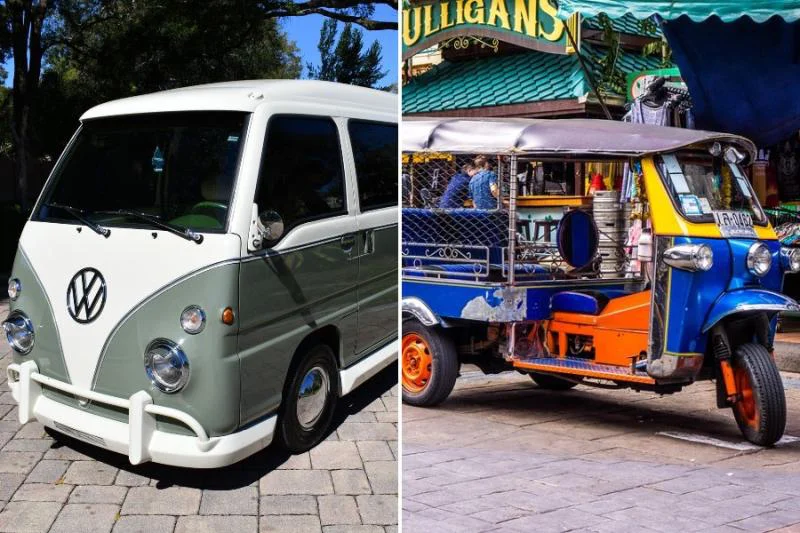Tricycles and microvans are small, multipurpose vehicles primarily made for getting around in cities or areas with many people. But they are made differently, work differently, and are used in different ways most of the time. Tricycles are vehicles with three wheels, usually powered by a small gas engine or an electric motor. They come in many different styles, like pedal-powered tricycles, tricycles with motors, and auto-rickshaws, which are common in India and the Philippines. Tricycles are versatile modes of transportation; they can be used to get around town on your own, transport passengers, or carry light loads. They are usually small, easy to move, and cheap, making them suitable for narrow streets and areas with many people. Tricycles are prevalent in developing countries because they are cheap and easy to use.
On the other hand, microvans are small, box-shaped vans with four wheels that can carry passengers and cargo. Most of the time, they have a small engine and can carry more weight than tricycles. Microvans often have sliding doors and rear hatches, making them easy to get in and out of. This makes them useful for small businesses, deliveries, or public transportation. Even though microvans are bigger than tricycles, they still have a small footprint, which makes them easy to drive in cities. Tricycles are built differently from microvans (three wheels vs four), serve different purposes (personal transportation, passengers, or small cargo vs increased load capacity and versatility), and are put to different uses (affordable transportation in developing countries versus urban deliveries and public transportation).
What is Tricycle?
A tricycle, also known as a trike, keke or tuk-tuk, is a vehicle with three wheels typically used for transportation and recreation. Tricycles can be powered by human effort, small gasoline engines, or electric motors and appear in various designs. Their lightweight construction, manoeuvrability, and straightforward design make them accessible and affordable to a wide range of users. The three-wheel design of pedal-powered tricycles provides stability and balance, minimising the risk of falls for children learning to ride bicycles. Tricycles for adults, which frequently include a cargo container or platform, are popular among senior citizens and those with mobility issues who want the benefits of cycling without the balance challenges of a conventional bicycle.
Tricycles with motors, such as auto-rickshaws and tuk-tuks, are common in India, the Philippines, and several African countries. Typically used as taxis in urban and rural areas, these vehicles provide essential passenger and small-cargo transportation. Their small size and manoeuvrability make them ideal for manoeuvring through congested streets and confined roads. Electric tricycles, or e-trikes, are acquiring popularity due to their low operating costs and eco-friendly nature. Using electric motors and rechargeable batteries, these tricycles provide a silent, efficient, and environmentally friendly mode of transportation. In sum, a tricycle is a versatile, three-wheeled vehicle available in pedal-powered, motorised, and electrified variants. Tricycles serve various user needs, including children learning to ride, adults desiring stable, eco-friendly transportation, and those providing essential services in developing nations.
What is Microvan?
A microvan is a compact, box-shaped vehicle designed to transport passengers, cargo, or both. It is also known as a kei van, mini van or mini bus. Microvans are typically outfitted with a small engine and have a small footprint, allowing them to navigate urban environments and tight spaces easily. They have gained popularity in densely populated areas and countries with narrow avenues, such as Japan, China, and some European and African nations. Microvans typically have four axles and make efficient use of space, allowing for a greater cargo or passenger capacity than their diminutive size would suggest. They usually have sliding doors and rear hatches, allowing for simple access and flexible cargo options. Inside microvans, seats may be foldable or detachable to facilitate a variety of cargo and passenger arrangements.
Microvans are commonly used for small businesses, deliveries, public transportation, and personal transportation. Their adaptability and fuel economy make them an economical option for various commercial applications, including courier services, mobile stores, and food vendors. Some microvans are also available with electric or hybrid powertrains, offering an alternative to conventional gasoline-powered vehicles. These environmentally friendly options appeal to consumers and businesses seeking to reduce their carbon footprint and save money on petroleum. A microvan is a small, adaptable vehicle for urban transportation and business use. Its efficient use of space, manoeuvrability, and adaptability to various cargo and passenger configurations make it a popular choice in densely populated areas among individuals and businesses.
Difference Between Tricycle and Microvan
Construction, functionality, and intended use are where microvans and tricycles diverge most sharply from one another. Small enterprises, delivery services, and public transportation frequently make use of microvans, which are four-wheeled, box-shaped vehicles meant to carry passengers or freight. They can carry greater weight than tricycles and can be arranged in more ways. In contrast, tricycles are compact three-wheelers that can be ridden for short distances and are ideal for short trips or transporting light loads. Because of their low cost and easy manoeuvrability, they are widely used in third-world countries. Microvans are designed to be flexible and carry more cargo than bicycles, whereas tricycles place emphasis on being inexpensive and easy to ride.
Construction and Wheels
Microvans have four wheels and a boxy appearance, whereas tricycles have three and a more basic design. This structural variation affects the vehicles’ sturdiness, visual appeal, and driving characteristics.
Passenger and Cargo Capacity
Due to their boxy appearance, microvans have more room inside for both passengers and freight. Tricycles can often only carry a few people or a small cargo.
Vehicle Purpose
Tricycles are commonly used for short-distance passenger and cargo transit, leisure activities, and personal transportation. Microvans are versatile enough to serve as private, work, delivery, and even public transit vehicles.
Engine and Power
Electric motors or hybrid drives power some microvans, while others rely on smaller gasoline or diesel engines. Tricycles can be pedal-powered, motorised with a small gasoline engine, or electronic, depending on the model and intended application.
Geographic Popularity
Auto rickshaws, tuk-tuks, and similar motorised tricycles are common modes of transportation in countries including India, the Philippines, and some in Africa. Microvans are more common in places like Japan, China, and some European and African countries where streets are narrow, and populations are high.







